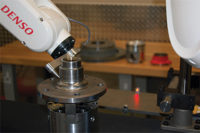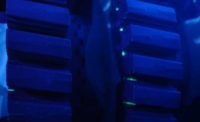As a quality manager, it’s your worst nightmare. One of your best customers comes for a visit and brings a box of cracked parts that came from your plant. He wants to know how it happened, and how you are going to ensure it won’t happen again.
None of us expects to make bad parts, but our raw materials, manufacturing flows, machinery and even personnel aren’t perfect. That’s why we inspect parts and keep a close eye on our processes.
TECH TIPSThe inspection technique used for your particular product will depend on the geometry of the part, the material composition of the part, and the type of flaws you are looking to find. Some of the techniques described here work best as an off-line, sample testing process.
Others are better suited to integration with assembly lines where all parts can |
Nondestructive testing techniques have been used to detect flaws in metals for decades. Different methods are suitable for different parts, and some are better for off-line batch testing vs. continuous in-line inspection.
We’re going to examine three of the more popular techniques including liquid penetrant and magnetic particle inspection, ultrasonic testing and eddy current testing. We’ll look at the best applications for using these techniques, the pros and cons of each, and recent advances in each technology.
Liquid Penetrant (PT) and Magnetic Particle Inspection
Liquid penetrant inspection offers an enhancement to visual inspection and is used to find surface flaws in non-porous metals. An early version of this technique was used in the late 1800s to find cracks in locomotive parts and incorporated heavy oil, kerosene and white chalk. In the 1940s, fluorescent dyes were added to the liquid penetrant increasing the visibility of surface flaws when used with a UV light.
Liquid penetrant inspection requires a part to be cleaned so that the dye can enter the flaws. Penetrant is then applied, the excess penetrant is removed and then developer is applied. An inspector then views it under appropriate lighting. Once the inspection is complete, the parts can be cleaned to remove the developer and dye.
Some of the advantages of liquid penetrant testing are as follows:
- Relatively simple and low cost
- Highly portable
- Highly sensitive to fine, tight discontinuities
- Can be used with complex geometries
Some of the limitations of liquid penetrant testing are as follows:
- Test surface must be free of dirt, oil, grease, paint, rust or any other contaminants
- Cannot be used on porous specimens and is difficult to use on very rough surfaces.
- Removal of all penetrant materials following the test is often required.
- Hard to automate and record data
Magnetic particle testing uses magnetic fields and small magnetic particles to detect flaws in ferromagnetic materials. The application was first used in the late 1800s when canons were magnetized and a magnetic compass was slid along the barrel looking for changes in the magnetic field. In the 1920s, it was discovered that colored metal shavings could be used with magnetism to find flaws.
Magnetic particle inspection can detect flaws that are open to the surface and just below the surface. The test specimen is magnetized with a permanent or electromagnet. Dry or wet magnetic particles that are visible under white light conditions or ultraviolet light conditions are spread onto the surface of the specimen. These particles create a visual indication approximating the size and shape of the flaw. Once the inspection is done, the part must often be demagnetized.
Advantages of magnetic particle testing include the following:
- Relatively simple and low cost
- Best method for the detection of fine, shallow surface cracks in ferromagnetic material
- Will work through thin coating
- Does not require stringent pre-cleaning
Some of the limitations of magnetic particle testing include the following:
- Material must be ferromagnetic
- Detects surface and near-to-surface discontinuities only
- Parts must often be demagnetized, which may be difficult
- Hard to automate for high speed or in-line production testing
New developments in UV-A LED light sources allow significant improvements in dye penetrant and magnetic particle inspections. UV-A LED lamps offer increased light intensity, increased efficiency, uniform beam patterns, and better ease of use. UV-A LEDs may allow a higher use of visible light during the inspection which may eliminate the need to perform inspections in darkened areas.
Ultrasonic testing (UT)
Ultrasonic testing uses high frequency sound waves to look for discontinuities or flaws in materials. The first experiments in using ultrasonic waves to detect flaws in solid materials were done in the 1930s. Rapid advancements in electronics and the use of ultrasonics in medical diagnostics have greatly advanced the capabilities of this technique. It is a well-established technique that can be used for welds and difficult-to-inspect geometries. It can also be used to see deep inside a part.
A UT system consists of a pulser/receiver, a transducer and a display. The pulser generates a high voltage electrical pulse which is turned into high frequency ultrasonic (sound) energy by the transducer. The transducer is coupled to the material via a gel or water. Signals reflected from flaws or discontinuities are transformed into an electrical signal by the transducer, are amplified and processed, and sent to a display. Received signal information can be used to calculate flaw location, size and orientation. UT can be used for thickness measurements as well as determination of mechanical properties and grain structures.
Some of the advantages of ultrasonic testing are:
- It has high sensitivity which permits detection of minute defects
- It has a high accuracy of measurement of flaw position and size
- It has fast response which permits rapid and automatic inspection
- It needs access to only one surface of the specimen
- It can find sub-surface flaws
Some of the limitations of this method are:
- It requires the use of a couplant
- Equipment can be expensive
- Highly skilled manpower is required
- Reference standards and calibration are required
- Automation for in-line production inspection can be expensive
Advances in computer software and modeling, robotics and transducer phased arrays have paved the way for rapid high resolution flaw mapping. Material handling systems and water baths can be used to integrate UT inspection into production lines.
Eddy current testing (ET)
Eddy current testing uses electromagnetic fields to find surface and near surface defects in metallic components. The science of electromagnetic induction was first developed in the mid-1800s. In the late 1800s, it was discovered that readings from a coil changed when placed in contact with metals of different conductivity. In the 1950s and 1960s, eddy current became a widespread technique used in the nuclear and aircraft industries.
In eddy current testing, an energized coil of wire is placed near a metal object causing eddy currents flow in that object. Flaws or material structure changes in that object cause the eddy currents to flow differently vs. a similar object without the flaws. Eddy current testing works by categorizing the differences in how these eddy currents flow. To inspect large areas, a set of eddy current coils are swept over a part to be inspected, either by moving the coils or moving the parts around the face of the coils.
Eddy current testing can be performed in a few seconds making it easy to integrate into a production line. Couplant is not required and parts do not have to be cleaned before testing.
Because eddy currents are affected by electrical conductivity, it can also be used to detect differences in alloys, heat treat conditions, proper case depth and even validate the proper implementation of a threaded hole.
Some of the advantages of eddy current testing include:
- Instantaneous responses
- Extreme sensitivity to surface flaws
- Green, requiring no chemicals or couplants
- Reliable with results that are reproducible
- Easy integration into production lines for 100% part inspection rates
Some of the limitations of eddy current testing include the following:
- It is applicable to metals only
- It can only detect surface flaws
- Equipment and material handling stations can be expensive
- A master set of parts or flaw standards must be produced
- It takes a trained operator to set up the equipment
Advances in electronics and computers have paved the way for eddy current arrays, multi-frequency testing, and data categorization and storage. Eddy current systems are now integrated into the full production flow where per part quality data can be captured and associated with each part manufactured.
Conclusion
The inspection technique used for your particular product will depend on the geometry of the part, the material composition of the part, and the type of flaws you are looking to find. Some of the techniques described here work best as an off-line, sample testing process. Others are better suited to integration with assembly lines where all parts can be inspected. In addition to the techniques reviews in this article, other techniques including radiographic testing, acoustic emission testing, and infrared/thermal testing can be considered. Best of all, one or more of these techniques should keep your customer from bringing you a box of flawed parts that you made.
References:
http://www-pub.iaea.org/mtcd/publications/pdf/tcs-11.pdf
http://www.asminternational.org/emails/enews/amp_pdfs/amp16606p39.pdf
https://www.nde-ed.org/EducationResources/CommunityCollege/communitycollege.htm




